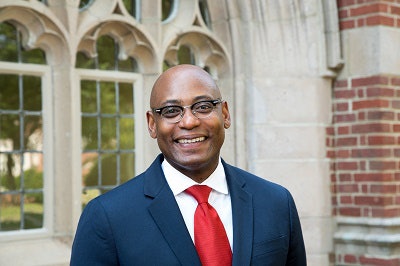A grim, June 2, 2020 YouTube video of Richmond, Virginia, Mayor Levar Stoney painfully conveys the crisis at hand for underrepresented leaders. Stoney, the thirty-nine-year-old lawyer who presides over a city still known today as the “Capital of the Confederacy,” happens to be Black, which in this particular moment was more a cause for astonishment than solidarity.
In the hourlong video, Stoney seems not for a single moment to be in charge of the 1,000 people that had gathered at City Hall in outrage after police pepper-sprayed and tear-gassed peaceful protesters two nights in a row. One can hear voices on the recording shouting “Where were you?” and “Fire Will,” referring to William Smith, the soon-ousted police chief. At one point Stoney, dismayed at the largely Black and Brown crowd, says, “I’ve been a Black man 39 years of my life.” The retort of “We can’t tell” encapsulates an excruciating moment of anguish, an occasion not for the faint of heart.
Stoney is emblematic but not alone. Lori Lightfoot, the gay, African American mayor of Chicago faced criticism from minority residents and others in June and July for her “geographic lockdown” of the city, essentially an act that re-segregated the city, if even temporarily.
 Dr. Patrice Rankine
Dr. Patrice RankineThe rift between underrepresented leaders and those we lead, some of whom also happen to be underrepresented, is not confined to politics. In the academic sphere, I have both an active role and a front-row seat to the spectacle, as an African American dean of one of the University of Richmond’s five schools, who serves under a president who also happens to be Black. Worse than “we can’t tell,” words not fit for print have been used to describe each of us, in earshot and otherwise.
These painful, public displays are worth our consideration, whether we are in positions of leadership or are the people that leadership serves.
First, crises can be opportunities to understand the differences—and the inescapable entanglements—between the role and one’s identity. A leadership role comes with various enactments, performative moments that are required of whoever fills it. For example, an academic dean hires faculty and manages their review. She oversees the creation and sunset of academic programs. She does so, however, within a system that preceded her and that will continue after she resigns. She is both contributor to and substantiation of the system. Whether or not she likes it, to those watching, the role can overshadow the narrative identity an individual brings to it. Serving a broader constituency than your identity group is tricky.
In the case of Stoney in Richmond, a fascinating illustration is how his position on the Confederate monuments shifted, from early in his first term, to the summer of COVID-19. Beyond political posturing, the shift — from a desire to historically contextualize the monuments to taking them all down in a fell swoop — speaks to public opinion. As it pertains to his identity as a Black man, Levar might well not lose a wink of sleep if he were never to see the likeness of a single Confederate soldier again. As it pertains to the role of mayor, however, laws, injunctions, and neighborhood associations all point to the crisis of performance. It can be difficult, even for an authentic leader, to separate one’s own feelings, convictions, or commitments, from the public pulls and postures.
Because “self” and “the role” are entangled, it is important, secondly, to continue analyzing each, knowing oneself, and knowing the system. By system, I refer to the set of entitlements and constraints to individual action, which are present for better and for worse. As innocuous as it may seem at first blush, being a Black, thirty-nine-year-old mayor of a Southern city was always going to be a wild ride.
Higher education leadership roles are no less political. It has been eye-opening to watch a Black university president establish an inclusive excellence framework at a Southern institution—no small feat. For colleges and universities, as with many other organizations, the system includes 1) a workforce not particularly well-disposed toward bias training; 2) leadership teams with their own challenges vis-à-vis diversity and intersectionality, and here I include gender, age, economic background, and political ideology; and 3) Boards of Trustees that represent similar challenges. These dynamics are operative whether the institution is in the South, Midwest, or Northeast.
As is the case with Stoney, we in academic leadership are in conversations across all of these intersectional differences, and students want change yesterday. They may not be particularly inclined to watch their demands of administration unfold across time and intersections. Change comes slowly or by revolution. The minority leader must “to thine own self be true,” first and foremost, even while seeking to serve the multiplicity of constituents well.
In all of these cases, finally, history is ultimately the judge of the minority leader. Here again, Stoney is emblematic. In his case, August already looks different from June. All but one of the Confederate monuments that lined Monument Avenue in Richmond, Virginia, are gone. Robert E. Lee stands alone. Many may still not be satisfied with Stoney’s resolution, but he chose a definitive path out of crisis, one he is still traveling, being true to himself while persevering in his role.
Stoney self-examined. He listened. He acted, even without a decisive end in sight. The arc of history is long. The leader, underrepresented or otherwise, can use crisis to refine a sense of self and her relationship to the people she serves.
Dr. Patrice Rankine is dean of the School of Arts & Sciences and Professor of Classics at the University of Richmond.



















